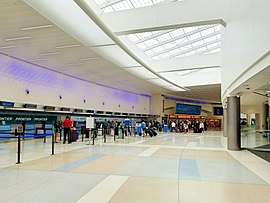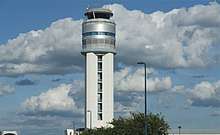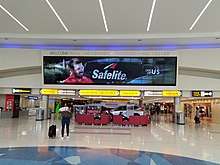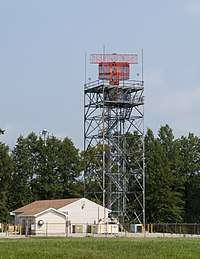John Glenn Columbus International Airport
John Glenn Columbus International Airport (IATA: CMH, ICAO: KCMH, FAA LID: CMH) is an international airport located 6 miles (9.7 km) east of downtown Columbus, Ohio. Formerly known as Port Columbus International Airport, it is managed by the Columbus Regional Airport Authority, which also oversees operations at Rickenbacker International Airport and Bolton Field. The airport code 'CMH' stands for "Columbus Municipal Hangar," the original name for the airport.[3]
John Glenn Columbus International Airport | |||||||||||||||
|---|---|---|---|---|---|---|---|---|---|---|---|---|---|---|---|
 | |||||||||||||||
 Departure level | |||||||||||||||
| |||||||||||||||
| Summary | |||||||||||||||
| Airport type | Public | ||||||||||||||
| Owner/Operator | Columbus Regional Airport Authority | ||||||||||||||
| Location | Columbus, Ohio | ||||||||||||||
| Elevation AMSL | 815 ft / 248 m | ||||||||||||||
| Coordinates | 39°59′53″N 082°53′31″W | ||||||||||||||
| Public transit access | |||||||||||||||
| Website | http://flycolumbus.com/ | ||||||||||||||
| Map | |||||||||||||||
 CMH Location of airport in Ohio / United States  CMH CMH (the United States) | |||||||||||||||
| Runways | |||||||||||||||
| |||||||||||||||
| Statistics (2019) | |||||||||||||||
| |||||||||||||||
John Glenn Columbus International Airport is primarily a passenger airport. It provides 148 non-stop flights to 31 airports via 9 airlines daily.[4]
On May 25, 2016, the Ohio General Assembly passed a bill to rename the airport from Port Columbus International Airport to its current name, in honor of astronaut and four-term U.S. senator John Glenn.[5] The name change was unanimously approved by the airport's nine-member board on May 24, 2016.[6] Ohio Governor John Kasich signed the bill into law on June 14, 2016 with the name change becoming official 90 days later.[7] On June 28, 2016, a celebration of the renaming was held and new signage bearing the airport's new name was unveiled.[8]
History
Early history
The airport opened July 8, 1929, on a site selected by Charles Lindbergh, as the eastern air terminus of the Transcontinental Air Transport air-rail New York to Los Angeles transcontinental route. Passengers traveled overnight on the Pennsylvania Railroad's Airway Limited from New York to Columbus; by air from Columbus to Waynoka, Oklahoma; by rail again on the Atchison, Topeka & Santa Fe from Waynoka to Clovis, New Mexico; and by air from Clovis to Los Angeles.[9] The original terminal building and hangars remain; the hangars are still in use, but the old terminal sits derelict.[10]
During World War II, most of the facility was taken over by the U.S. Navy, which established Naval Air Station Columbus in 1942. NAS Columbus was closed and the facility relinquished back to civilian authorities in 1946.[11][12] Also, during the war, the government established a government-owned aviation factory on the grounds of the airport known as Air Force Factory 85, eventually operated by North American Aviation. The plant produced the F-100 Super Saber, RF-6 Vigilante, T-2 Buckeye, T-28 Trojan, OV-10 Bronco and T-39 Sabreliner.
The diagram on the February 1951 Coast & Geodetic Survey instrument-approach chart shows runways 006/186 3550 ft long, 052/232 4400 ft, 096/276 4500 ft, and 127/307 5030 ft.
A new $12 million terminal building opened on September 21, 1958.[10] Jet airline flights (American 707s) started in April 1964.

Historical airline service
The April 1957 Official Airline Guide shows 72 airline departures each weekday: 41 TWA, 16 American, 6 Eastern, 6 Lake Central and 3 Piedmont.[13]
The first major airline to fly into Columbus was TWA, and it kept a presence at Columbus over 70 years during the era of airline regulation.[10] TWA offered a club for exclusive passengers up until 2000 when America West took over a gate held by TWA and the club itself due to financial problems.[14]
Columbus was formerly a hub of America West Airlines in the 1990s, but the company closed the hub in 2003 due to financial losses and the post 9/11-decline in air travel.[14]
The airport was the home base of short-lived Skybus Airlines, which began operations from Columbus on May 22, 2007. The airline touted themselves as the cheapest airline in the United States, offering a minimum of ten seats for $10 each on every flight. Skybus ceased operations April 4, 2008.[15]
Recent improvements
A $70 million renovation of airport facilities, designed by Brubaker, Brandt Inc., was initiated in 1979 for the airport's 50th anniversary and completed in 1981.[16] This upgraded the airport's capacity to 250 flights per day by adding what is known today as Concourse B and added fully enclosed jetways at every gate.[10] Ten years later in 1989, a second, $15.5 million, seven-gate south concourse (now Concourse A) was dedicated.[10] The concourse was used exclusively by US Airways at the time, and later housed hubs for both America West Airlines until 2003, and Skybus Airlines until they shut it down in 2008 due to their bankruptcy. A north concourse was completed in 1996, which is now Concourse C, and was expanded in 2002.[10]
Between 1998 and 2000, numerous airport expansion and renovation projects were completed, including a $25 million terminal renovation in 1998 that included additional retail shops, new flight information displays, enhanced lighting, upgraded flooring, and a new food court. Also, new hangars and office spaces were completed for NetJets in 1999, as well as a $92 million parking garage including an underground terminal entrance, new rental car facilities, dedicated ground transportation area, improved eight-lane terminal access on two levels, and a new atrium and entrances in 2000, which were designed by URS Corporation.[10][17]
On April 25, 2004, a new 195-foot (59 m) control tower directed its first aircraft. This began several major facility enhancements to be constructed through 2025.[10] On October 21, 2010, a new arrivals/departures board replaced the old one in the main entrance area
Columbus began its Terminal Modernization Program in late 2012, which included new terrazzo flooring throughout the airport, new ceilings, new restrooms, more TSA security lanes, and new LED lighting. Construction started on Concourse A in late 2012 and was completed throughout the terminal in early 2016.[18]
In 2013, the airport completed a $140 million runway improvement that moved the south runway farther from the north runway. This created a buffer distance that enables simultaneous takeoffs and landings on the north and south runways, increasing air traffic volume. Columbus mayor Michael B. Coleman commented, "As the city grows, the airport needs to grow with it."[19]
Facilities


On-site facilities
In 2001, Executive Jet Aviation (now known as NetJets), opened up a 200,000-square-foot (19,000 m2) operational headquarters[20]
In November 2006, Skybus Airlines began leasing 100,000 square feet (9,300 m2) of office and hangar facilities at the Columbus International AirCenter adjacent to the airport.[21]
Regional carriers Envoy Air and Republic Airways operate large maintenance bases at the airport.
The airport has its own police and fire departments (ARFF-C).
Airfield
The original 1929 layout for the airport covered 524 acres (212 ha), with two runways 2,500 and 3,500 feet (760 and 1,070 m) long.[22] In 1952 the current south runway was lengthened to 8,000 feet (2,400 m), making it the longest runway in the midwest at the time.[10] The north runway was extended to 8,000 feet (2,400 m) in 1997[10] and the south runway has since been extended to 10,113 feet (3,082 m). John Glenn Columbus International Airport covers 2,265 acres (917 ha) and has two runways:[23]
- Runway 10R/28L: 10,114 ft × 150 ft (3,083 m × 46 m), air carrier runway, ILS equipped.
- Runway 10L/28R: 8,000 ft × 150 ft (2,438 m × 46 m), air carrier runway, ILS equipped.
Runway 10L/28R is just north of the 40th parallel north.
An expansion in 2008–2009 moved the primary access road to the main terminal, over which a new aircraft bridge was built. The Port Columbus Airport Crossover Taxiway Bridge was intended to ease congestion of aircraft traffic and allow aircraft to move from the main terminal to outer runways.[24]
Terminal
John Glenn Columbus International Airport has one terminal and 3 concourses.
Concourse A was built in 1989 for US Airways and is currently home to Southwest, which uses all the gates with the exception of A1 (no jet bridge) and A7 (ground-level boarding gate).
Concourse B is the original section of the current CMH terminal built in 1958 and is home to Air Canada (B30), American (B19-26, 28), Spirit (B35-36), and United (B29-32, 34). Gates B15 through B18 and B33 are no longer accessible due to concession and restroom construction; gate B33 has had its jet bridge removed. There is no B27.
Concourse C opened in 1995 for Delta and Southwest and extended in 2002, is home to Alaska (C49), Delta (C48-56) and Frontier (C47). Vacation Express charters also depart from Concourse C, typically using Gate C46, which is also used for international arrivals and connects directly to customs and immigration. Currently, the only international arrivals are the seasonal flights from Cancún and Punta Cana, as well as the daily flights to Toronto–Pearson.
Ground transportation
The airport is accessible directly by taking exit number nine on Interstate 670 to International Gateway. Alternatively, drivers can also get to the airport from the east via Hamilton Road, just south of Interstate 270, and enter at Sawyer Road or from the west via Stelzer Road.
In addition to housing the rental car facilities, a six-story parking garage (which is attached to the terminal) provides long-term and short-term parking. Lower cost satellite parking options, with continuous free shuttle service, can be found in the Blue, Red and Green parking lots along International Gateway. The Blue lot is the closest to the terminal and also offers some covered parking. The cost of parking a car in the blue lot is $9 per 24 hours. The Red Lot costs $7 per 24 hours and the green lost costs $5 per 24 hours to park. The Green lot is the furthest away from the terminal. Additionally, there is a free cell phone lot accessed from the outbound side of International Gateway.[25][26]
The Columbus Metropolitan Area's bus service, the Central Ohio Transit Authority (COTA), has two bus services between the airport and downtown Columbus. AirConnect, a service that began in 2016, stops at the arrival and departure levels every 30 minutes.[27] COTA's 7 Mt. Vernon route is operated from downtown, with every other bus serving either the airport or Easton Transit Center.[28][29]
The GoBus Rural Inter-City Bus Service operates a thrice daily schedule to Athens, via Lancaster, Logan, and Nelsonville.[30]
Inbound taxi services operate through numerous taxi businesses in the Columbus area. A number of taxi services provide outbound transportation in the taxi lane.[31]
Airlines and destinations
Passenger
| Airlines | Destinations | Refs |
|---|---|---|
| Air Canada Express | Toronto–Pearson | [32] |
| Alaska Airlines | Minneapolis/St Paul, Seattle/Tacoma | [33] |
| American Airlines | Charlotte, Dallas/Fort Worth, Los Angeles, Phoenix–Sky Harbor Seasonal: Chicago–O'Hare, New York–LaGuardia, Philadelphia | [34] |
| American Eagle | Charlotte, Chicago–O'Hare, Miami, New York–JFK, New York–LaGuardia, Philadelphia, Washington–National | [34] |
| Delta Air Lines | Atlanta, Los Angeles, Minneapolis/St. Paul, Seattle/Tacoma (begins June 8, 2020) Seasonal: Cancún, Detroit, Salt Lake City | [35] |
| Delta Connection | Boston, Detroit, Minneapolis/St. Paul, New York–JFK, New York–LaGuardia, Raleigh/Durham Seasonal: Fort Myers, Miami, Orlando | [35] |
| Frontier Airlines | Denver, Orlando | [36] |
| Southwest Airlines | Atlanta, Baltimore, Boston, Chicago–Midway, Dallas–Love, Denver, Fort Lauderdale, Fort Myers, Houston–Hobby, Las Vegas, Nashville, New Orleans, Orlando, Phoenix–Sky Harbor, St. Louis, Tampa, Washington–National Seasonal: Cancún | [37] |
| Spirit Airlines | Fort Lauderdale, Las Vegas, Orlando Seasonal: Fort Myers, Myrtle Beach, New Orleans, Tampa | [38] |
| United Airlines | Chicago–O'Hare, Denver, Washington–Dulles Seasonal: San Francisco | [39] |
| United Express | Chicago–O'Hare, Houston–Intercontinental, Newark, Washington–Dulles | [39] |
Statistics

Top destinations
| Rank | City | Passengers | Carriers |
|---|---|---|---|
| 1 | Atlanta, Georgia | 477,190 | Delta, Southwest |
| 2 | Chicago–O'Hare, Illinois | 336,340 | American, United |
| 3 | Orlando, Florida | 227,110 | Delta, Frontier, Southwest, Spirit |
| 4 | Chicago–Midway, Illinois | 182,600 | Southwest |
| 5 | Denver, Colorado | 181,730 | Frontier, Southwest, United |
| 6 | Dallas/Fort Worth, Texas | 179,510 | American |
| 7 | Charlotte, North Carolina | 161,100 | American |
| 8 | New York–LaGuardia, New York | 151,890 | American, Delta |
| 9 | Las Vegas, Nevada | 143,740 | Frontier, Southwest, Spirit |
| 10 | Washington–National, D.C. | 139,120 | American, Southwest |
Annual traffic
| Year | Passengers | Year | Passengers |
|---|---|---|---|
| 2000 | 6,873,998 | 2010 | 6,366,122 |
| 2001 | 6,680,897 | 2011 | 6,378,722 |
| 2002 | 6,740,935 | 2012 | 6,350,446 |
| 2003 | 6,252,233 | 2013 | 6,236,528 |
| 2004 | 6,232,332 | 2014 | 6,355,974 |
| 2005 | 6,611,575 | 2015 | 6,758,334 |
| 2006 | 6,733,990 | 2016 | 7,324,180 |
| 2007 | 7,719,340 | 2017 | 7,576,592 |
| 2008 | 6,910,045 | 2018 | 8,141,656 |
| 2009 | 6,233,485 | 2019 | 8,637,108 |
Airline market share
| Rank | Carrier | Passengers | Percentage |
|---|---|---|---|
| 1 | Southwest Airlines | 2,851,702 | 33.01% |
| 2 | American Airlines | 2,053,530 | 23.78% |
| 3 | Delta Air Lines | 1,851,913 | 21.51% |
| 4 | United Airlines | 1,127,247 | 13.05% |
| 5 | Spirit Airlines | 450,710 | 5.22% |
Accidents and incidents
- On June 27, 1954 an American Airlines Convair CV-240 (N94263) from Dayton International Airport was on approach to Runway 27 at 300 feet (91 m) when the left side of the plane collided with a US Navy Beechcraft SNB-2C Navigator (BuA23773), also on approach. The Convair recovered and landed, though the nose gear collapsed on landing. The Beechcraft crashed short of the runway, killing two on board. The probable cause was attributed to "A traffic control situation created by the tower local controller which he allowed to continue without taking the necessary corrective action. A contributing factor was the failure of both crews to detect this situation by visual and/or aural vigilance."[44]
- On January 7, 1994, United Express Flight 6291 was a BAe Jetstream 41 being operated by Atlantic Coast Airlines; it was on approach to runway 28L when it entered into a stall at 430 feet (130 m) above runway level. The aircraft collided with a stand of trees and came to rest inside a commercial building 1.2 miles (1.9 km) short of the runway and burst into flames. The accident killed all three crewmembers and two of five passengers. The probable cause was attributed to "(1) An aerodynamic stall that occurred when the flight crew allowed the airspeed to decay to stall speed following a very poorly planned and executed approach characterized by an absence of procedural discipline; (2) Improper pilot response to the stall warning, including failure to advance the power levers to maximum, and inappropriately raising the flaps; (3) Flight crew experience in 'glass cockpit' automated aircraft, aircraft type and in seat position, a situation exacerbated by a side letter of agreement between the company and its pilots; and (4) the company's failure to provide adequate stabilized approach criteria, and the FAA's failure to require such criteria. Member Vogt concluded that the last factor was contributory but not causal to the accident. Additionally, for the following two factors, Chairman Hall and Member Lauber concluded that they were causal to the accident, while Members Vogt and Hammerschmidt concluded they were contributory to the accident: (5) The company's failure to provide adequate crew resource management training, and the FAA's failure to require such training; and (6) the unavailability of suitable training simulators that precluded fully effective flight crew training."[45]
See also
- Brushstrokes in Flight
References
- "Columbus Regional Airport Authority" (PDF). Archived from the original (PDF) on December 14, 2010.
- "Port Columbus Sets New Passenger Record in 2007". Columbus Regional Airport Authority. January 25, 2008. Archived from the original on September 3, 2009. Retrieved February 11, 2008.
- "Airport ABCs: An Explanation of Airport Identifier Codes". skygod.com. Retrieved July 22, 2007.
- "2020 Sample Flight Schedule" (PDF). Columbus Regional Airport Authority. March 2020. Retrieved April 4, 2020.
- "Bill naming John Glenn airport passes in Ohio". Associated Press.
- Julie Carr Smyth (May 25, 2016). "Ohio Airport to Be Named in Honor of Astronaut John Glenn". Associated Press. Retrieved June 16, 2016.
- Johnson, Alan (June 14, 2016). "Law signed naming John Glenn International Airport". The Columbus Dispatch. Retrieved June 16, 2016.
- "Ohio's Columbus airport renamed for astronaut John Glenn". Retrieved July 1, 2016.
- Fred J. Bunyan (January 1959). "Columbus Prepared for Progress". Flying Magazine.
- "Port Columbus Milestones". Columbus Regional Airport Authority. 2012. Retrieved July 28, 2012.
- "Data" (PDF). epa.ohio.gov.
- "Item - National Naval Aviation Museum".
- Official Airline Guide, Washington DC: American Aviation Publications, 1957
- "America West in Columbus". PSA History Page. 2003–2007. Archived from the original on August 10, 2007. Retrieved July 22, 2007.
- "Skybus To End Operations". 10TV.com. April 4, 2008. Retrieved March 9, 2018.
- "Engineering News-Record". Engineering News-Record. 202 (1–13): 271. 1979. Retrieved June 28, 2012.
- "AECOM".
- "Terminal Modernization Program – At Port Columbus – FlyColumbus".
- Weese, Evan (August 22, 2013). "Port Columbus 'Staying Ahead of Demand Curve' With New South Runway". Columbus Business First.
- "Executive Jet, Inc. Inaugurates New Operations Center". Netjets Inc. June 14, 2000. Archived from the original on September 27, 2007. Retrieved August 16, 2007.
- "Skybus will establish headquarters at Columbus International AirCenter". Skybus Airlines Inc. November 10, 2006. Archived from the original on July 10, 2007. Retrieved August 16, 2007.
- "75 Years of Flight in Columbus". Columbus Regional Airport Authority. 2004. Archived from the original on February 5, 2005. Retrieved August 16, 2007.
- FAA Airport Master Record for CMH (Form 5010 PDF), effective November 18, 2010
- Kevin M. Gorak and Troy D. Jessop (Winter 2009). "A New Welcome at the Port Columbus International Airport" (PDF). Aspire: 34–37. Retrieved September 13, 2016. (with 4 pages of additional photos published in the web version)
- "Parking Maps". Columbus Regional Airport Authority. 2007. Archived from the original on August 16, 2007. Retrieved August 16, 2007.
- "Shuttle Lots and Airport Property". Columbus Regional Airport Authority. 2009. Archived from the original on December 7, 2009. Retrieved December 5, 2009.
- "COTA plans bus line between airport and Downtown". Retrieved February 20, 2016.
- https://flycolumbus.com/getting-to-from/public-transportation
- https://www.cota.com/wp-content/themes/gotravel-child/PDF/lines/7.pdf
- "Route A: Columbus // Athens // Parkersburg Schedule -". ridegobus.com.
- "Taxi Services". Columbus Regional Airport Authority. 2007. Archived from the original on July 13, 2007. Retrieved July 22, 2007.
- "Flight Schedules". Retrieved January 7, 2017.
- "Flight Timetable". Retrieved August 29, 2018.
- "Flight schedules and notifications". Retrieved January 7, 2017.
- "FLIGHT SCHEDULES". Retrieved January 7, 2017.
- "Frontier". Retrieved January 7, 2017.
- "Check Flight Schedules". Retrieved April 7, 2018.
- Inc., Spirit Airlines. "Spirit Airlines Adds Columbus, Ohio to its Growing Network".
- "Timetable". Retrieved January 7, 2017.
- "RITA – BTS – Transtats". Bureau of Transportation Statistics. Retrieved April 4, 2020.
- "Port Columbus Air Service Reports". flycolumbus.com. Retrieved July 10, 2014.
- "Comprehensive Annual Financial Report (pg 61). Retrieved Mar 29, 2015" (PDF). Archived from the original (PDF) on April 2, 2015. Retrieved March 29, 2015.
- "Fly Columbus Traffic Report" (PDF). Columbus Regional Airport Authority. January 28, 2020. Retrieved April 4, 2020.
- "ASN Aircraft accident description Convair CV-240-0 N94263". Aviation Safety Network. 1954. Retrieved November 13, 2007.
- "ASN Aircraft accident description British Aerospace BAe 4101 Jetstream 41 N304UE". Aviation Safety Network. 1994. Retrieved November 13, 2007.
External links
| Wikimedia Commons has media related to John Glenn Columbus International Airport. |
- National Air Traffic Controllers Association (NATCA) CMH Local
- John Glenn Columbus International Airport (official site)
- Real-Time Flight Information for John Glenn Columbus International Airport
- FAA Airport Diagram (PDF), effective April 23, 2020
- Resources for this airport:
- AirNav airport information for KCMH
- ASN accident history for CMH
- FlightAware airport information and live flight tracker
- NOAA/NWS weather observations: current, past three days
- SkyVector aeronautical chart for KCMH
- FAA current CMH delay information